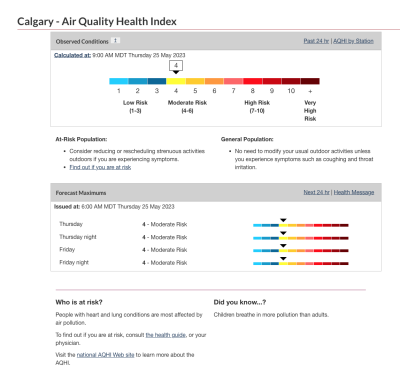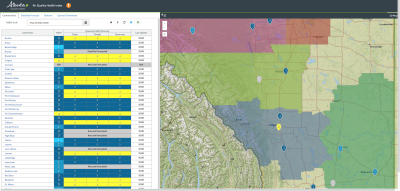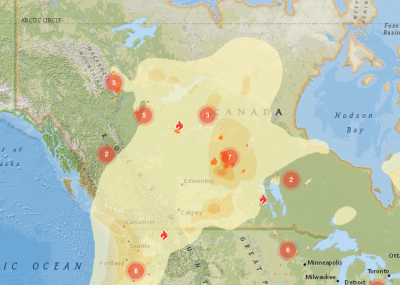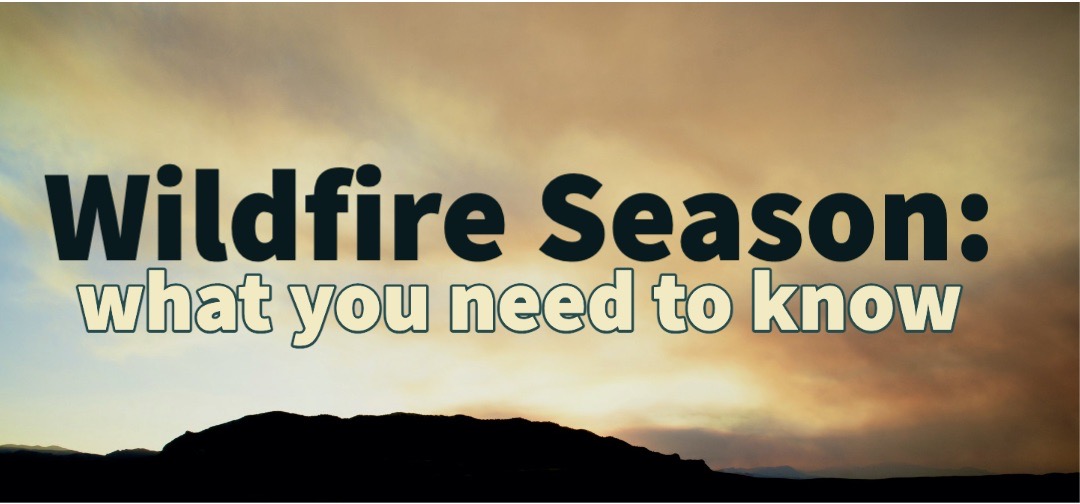Introduction
Wildfire season has hit Alberta hard this year, and many people are wondering how they can protect themselves from the overwhelming smoke at home, at school and at work.
What is wildfire smoke made up of?
Wildfire smoke is a mixture of gases and fine particulates from burning trees and vegetation. The composition of the smoke will vary, depending on the fuel burning and conditions under which it is burnt. Smoke is primarily made up of carbon dioxide, water vapour, carbon monoxide, particulate matter, hydrocarbons and other organics, nitrogen oxides and trace minerals.
The major substance of concern is particulate matter (PM). Particulate is a general term for a mixture of solid particles and liquids suspended in air. Wildfire particulates are typically very small (less than 2.5 microns in diameter) and they scatter light, reducing visibility. These small particulates are often referred to as PM2.5.
Another substance of concern is carbon monoxide, a product of incomplete combustion produced primarily during the smouldering stages of a fire.
Hazardous chemical pollutants such as acrolein, benzene and formaldehyde are also present in smoke in far lower concentrations than particulates and carbon monoxide.
What health effects does wildfire smoke have?
The fine particulate matter contains carbon, sulphur and nitrogen compounds, metals and organic chemicals and is the main component causing irritation. The smoke may cause eye irritation, lung disease and it can worsen a chronic heart. Chemicals like formaldehyde and acrolein cause irritation and may trigger asthma. In addition to this, it is possible that it impairs cognitive function. In a study the EPA completed on luminosity players between 2017 and 2018, it was found that wildfire smoke and pollution particulates can have significant effects on brain performance. The study found that within hours of exposure, particulate matter (PM2.5) can reduce attention in adults.
How do we know whether the air quality is good or bad?
The Government of Canada provides data on the Air Quality Index (AQHI) for various regions of the country, which rates the air quality as low risk (1-3), moderate risk (4-6), high risk (7-10) or very high risk (>10). The page also gives guidance for at-risk populations and the general population.

Alberta also has a map which shows AQHI for various municipalities.

The AQHI is based on the following five air pollutants: carbon monoxide, nitrogen dioxide, ozone, particulate matter (PM2.5) and sulphur dioxide.
The AQHI is at high risk if any of the following are exceeded:
- 80 ug/m3 for PM2.5
- 82 ppb for ozone
- 159 ppb for nitrogen dioxide
- 172 ppb for sulphur dioxide
- 13 ppm for carbon monoxide
- 1 ppm for hydrogen sulphide and total reduce sulphur
Another helpful tool is FireSmoke Canada, which gives a forecast of smoke conditions in an interactive map.

CIHC can perform assessments for these various components in your area. Most commonly, PM2.5 and carbon monoxide are used as surrogates for overall air quality. Visit us on our contact us page for any queries you may have about our services.
How do we protect ourselves from wildfire smoke?
When controlling an exposure, we first want to look at eliminating the hazard. Do we need to be exposed to the smoke on a poor air quality day?
We can choose to remain indoors as much as possible. The indoor air also needs to be improved during a wildfire. This can be done by ensuring all windows are closed and reducing outdoor air being introduced into the building space.
The air introduced into the building space should be filtered as thoroughly as possible. Ideally, using a MERV 13 particulate filter or higher should reduce the amount of PM2.5 particles. Not all HVAC systems can handle these finer particulate filters. Ensure you consult the furnace manufacturer to determine options. For more on filtration, there is some good information here. A charcoal prefilter can also be used to decrease odours caused by organic materials within the building space, more on activated charcoal here.
Canadian Association of Petroleum Producers (CAPP) gives some excellent guidance on sheltering in place in their document Emergency Preparedness Guide for Hazards Associated with Wildfires, including the use of air conditioners, air cleaners and humidifiers to reduce particulate levels in section 3.5.1 in the document.
If we do have to be outdoors, we can filter the air we are breathing with air purifying respirators. A cartridge-style respirator is ideal because it gives you a better seal and you have various options for cartridges. A multi-gas cartridge will cover not only particulate with a P-100 cartridge, but also organic vapors, sulphur dioxide and hydrogen sulphide. Each manufacturer has cartridge guides that tell you what compounds they can filter.
For ease of use, many people choose N95 respirators which filter out particulate only and are disposable. Some N95s have a combination of charcoal and particulate filtration.
Whatever respirator you use, it is highly important to ensure that it is worn properly. We have a blog on this topic here.
Conclusion
Wildfire smoke contains a variety of components, but the component of most concern is fine particulate. The AQHI is a helpful tool which can guide our decisions on what type of activities we can participate in during wildfire smoke events. We protect ourselves from wildfire smoke by filtering our indoor air and filtering the air we are breathing while outdoors.
Please feel free to contact us if you have any questions about wildfire smoke and our services.

